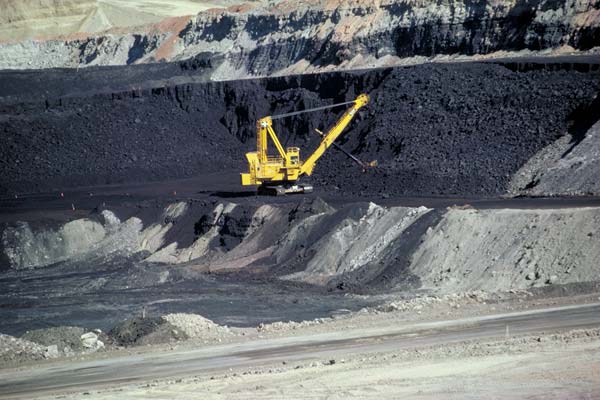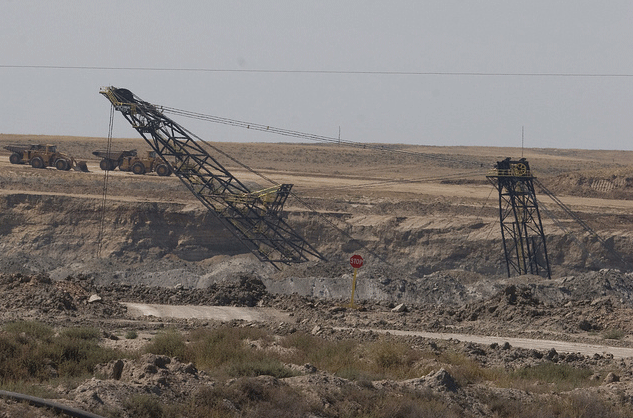Wyoming Coal
Air Date: Week of October 19, 2012

Some 5 deep water ports in the Pacific Northwest are under consideration as terminals to export coal from Wyoming and Montana . Ashley Ahearn from Earth Fix reports that they would principally be used to bring coal from Wyoming to markets in Asia.
Transcript
CURWOOD: It’s Living on Earth, I'm Steve Curwood. As many as five deep water ports in Washington and Oregon are considering building terminals to export American coal to Asia. The coal would come from mines in Wyoming and Montana and would travel by train through the Northwest.
That has governmental agencies, environmental groups, Native Americans, labor and industry in an increasingly fierce debate. Ashley Ahearn of the public radio collaborative EarthFix has our story from Wyoming coal country.
AHEARN: The U.S. produces about a billion tons of coal every year. Almost half of it is mined here in the Powder River Basin – in the Northeastern corner of the state of Wyoming.
[CAR SOUNDS]
WILLIAMS: This is Keith Williams. We’re touring the Black Thunder Coal mine in Gillette, WY.
AHEARN: This is one of the largest open pit mines in the world, and Keith Williams runs it.
WILLIAMS: Down we go.
AHEARN: Williams steers the truck along a dirt road - 300 feet down into the mine. The first thing that hits you is the sheer size of this operation. Dump trucks as big as California bungalows rumble around us. Back and forth they go - clearing away millions of pounds of clay and dirt to get at the rich coal seam underneath. It’s like peering into an ant colony under siege.
[DOORS OPENING, SHUTTING, LOUD MACHINE NOISE FADES UP]
AHEARN: And then we arrive at the core of the mine.
WILLIAMS: It’s the big one, it’s the queen bee. It’s the big machine.
AHEARN: We get out of the truck and stand in front of what’s called a dragline. It looks like a crane attached to an apartment building, swiveling back and forth, with a giant bucket suspended from one end to scoop earth. All of this to get to the black gold buried beneath. Some of this coal could end up being shipped out of terminals on the Washington coast.

An open pit coal mine in the Powder Ridge Basin of Wyoming. (Photo: Kimon Berlin)
Within a 60-mile radius from where we’re standing there are 12 other strip mines like this one. They encircle the city of Gillette like a string of black pearls - or gaping holes in the earth. But where some see gaping holes, others see jobs.
LUBNAU: Gillette depends hugely on the coal industry.
AHEARN: Tom Lubnau is a state representative. He came to Gillette when he was 6 months old and has seen the city boom as coal companies pumped money into the local economy.
LUBNAU: They’re a great corporate citizen. They contribute well to our communities. In terms of a lot of things. The coal industry statewide has built a billion dollars worth of schools.
AHEARN: The coal industry employs 5,000 people in the mines of Campbell County – the center of mining operations in the Powder River Coal deposit. The average income here is 60,000 dollars a year.
LUBNAU: Gillette has become a marvelous place to live. Very low crime rate. Marvelous facilities, swimming pools, recreation centers, running tracks, parks.
AHEARN: Overwhelmingly, people here are proud of the coal industry. It is one of the key economic forces that transformed Gillette from a cow town along the rail line into a mini-metropolis amidst these dry rolling grasslands.
[FOOTSETPS ON GRAVEL PATH, FAINT COW SOUNDS IN THE BACKGROUND]
AHEARN: The sun’s setting as LJ Turner takes me out for a walk along the creek near his red-roofed ranch house.
TURNER: I’ve been here all my life and my family’s been here since 1918.
AHEARN: Turner and his wife Karen run Red Angus cows and sheep on this 10,000 acre ranch about 10 miles from the Black Thunder mine.
TURNER: When I was small we got our ice out of the creek for the household use. My job was to tamp sawdust around the blocks of ice then and we’d have enough ice that it would keep our household needs for the year.
AHEARN: Now the creek is a muddy trickle. Turner believes mining has destroyed the underground aquifers that feed this creek and others on his property. He’s extended his well down 1000 feet beneath his house and it’s still running dry.
Turner’s also upset that some of the nearby grazing land he used to lease from the Forest Service has now been leased to the coal companies to be mined. But alongside the local impacts, Turner worries about what burning more fossil fuels will do to the global climate. He says the impacts here are already clear.
TURNER: The first winter that Dad was here in 1919, he said it never got above 20 below for 6 weeks. But this last winter it froze up, but it didn’t freeze hard. We had green grass in February and it’s changing, it really is.
AHEARN: Turner looks out at a mule deer grazing nearby and pauses for a minute.
TURNER: I’m scared of it. I’m just scared of it.
[COW SOUNDS]
AHEARN: The forces that dictate how much coal is mined and where it ends up being burned are far away from these dry grasslands. US coal consumption is at a 40 year low, largely because of a boom in cheap natural gas. But international demand for coal is expected to rise 65 percent in the next 20 years or so. The majority of that increase will be in Asia.
That has Powder River Basin coal companies looking for ways to get their product across the Pacific as quickly and cheaply as possible. And they’re eyeing the Pacific Northwest as the fastest route. I’m Ashley Ahearn in Gillette, Wyoming.
[MUSIC: Hugh Masakela “Stimela (Coal Train) “ from Grazing In The Grass – The Best Of Hugh Masakela (Sony Music 1996).]
CURWOOD: Ashley's story comes to us from public radio's EarthFix. You can find more about Wyoming coal by digging into our website, loe dot org.
Links
Vermont Law School Article on Wyoming’s Powder Ridge Basin and Coal
Living on Earth wants to hear from you!
Living on Earth
62 Calef Highway, Suite 212
Lee, NH 03861
Telephone: 617-287-4121
E-mail: comments@loe.org
Newsletter [Click here]
Donate to Living on Earth!
Living on Earth is an independent media program and relies entirely on contributions from listeners and institutions supporting public service. Please donate now to preserve an independent environmental voice.
NewsletterLiving on Earth offers a weekly delivery of the show's rundown to your mailbox. Sign up for our newsletter today!
 Sailors For The Sea: Be the change you want to sea.
Sailors For The Sea: Be the change you want to sea.
 The Grantham Foundation for the Protection of the Environment: Committed to protecting and improving the health of the global environment.
The Grantham Foundation for the Protection of the Environment: Committed to protecting and improving the health of the global environment.
 Contribute to Living on Earth and receive, as our gift to you, an archival print of one of Mark Seth Lender's extraordinary wildlife photographs. Follow the link to see Mark's current collection of photographs.
Contribute to Living on Earth and receive, as our gift to you, an archival print of one of Mark Seth Lender's extraordinary wildlife photographs. Follow the link to see Mark's current collection of photographs.
 Buy a signed copy of Mark Seth Lender's book Smeagull the Seagull & support Living on Earth
Buy a signed copy of Mark Seth Lender's book Smeagull the Seagull & support Living on Earth

